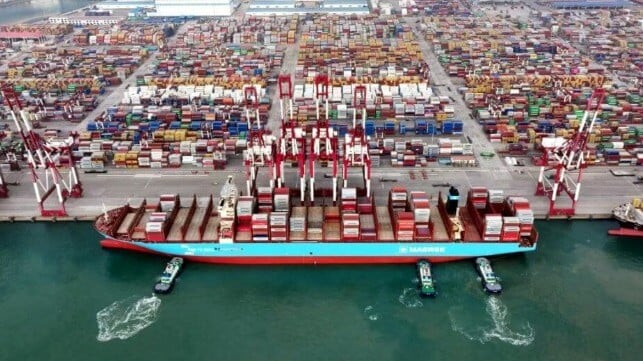Maersk Redeploys Maersk Halifax After First Conversion to Methanol

Maersk is reporting that it has successfully redeployed its first-ever methanol conversion containership back into the fleet. The Maersk Halifax is underway making its final call in Asia before crossing the Pacific to Mexico and Panama on its first post-conversion voyage.
“We are happy to announce that Maersk Halifax successfully has been retrofitted into a dual-fuel methanol vessel. Following the completion of the sea trials, Maersk Halifax has returned to operation and is now servicing our customers on the Trans-Pacific trade,” said Leonardo Sonzio, Head of Fleet Management and Technology at Maersk.
The conversion project, which required 88 days at the Zhoushan Xinya Shipyard in China and was completed at the end of October 2024. The ship underwent sea trials late last month with the official handover to Maersk on October 29. She left the anchorage on November 5 making port calls in Shanghai and loaded 5,532 TEUs of export containers at Qingdao Port before making a call in Busan, South Korea. After a call this week in Yokohama, Japan, she is due to depart on November 20 and arrive at the APM Terminals Lazaro Cardenas on December 2.
The project was more complex than other conversions. It was based on a 2017-built vessel, Maersk Honam that was part of the Hong Kong class built by Hyundai. She was originally built with an overall length of 1,158 feet (353 meters) and a capacity of 15,226 TEU. Maersk Honam suffered a tragic fire that killed five crewmembers in 2018 and heavily damaged the forward section of the vessel. The company decided to salvage the ship, cutting the vessel just aft of the deck house and bridge and putting a new forward section onto the ship. She returned to service, renamed Maersk Halifax, in April 2019.
She arrived in China for her special survey and the conversion in July 2024. The engine conversion was carried out by MAN Energy Solutions. Besides replacing machine parts and thereby making the engine able to operate on methanol, the retrofit operation at the yard involved adding new fuel tanks, a fuel preparation room, and a fuel supply system.
The hull was also been expanded to accommodate the fuel tanks. With this change, the length of the ship was extended by 15 meters (49 feet) to 368 meters (1,207 feet), increasing the capacity from around 15,000 to 15,690 TEU. The new dwt is listed at 185,000 tons for the Singapore-registered vessel.
Maersk calls the conversion a demonstration that will provide learning as they seek to expand the deployment of methanol and other green fuels. They said the intent was to convert a sister ship timed to a special survey due in 2027 while MAN said it has been contracted for the potential conversion of all 11 ships of the class.
“In the coming year, we will take learnings from this first conversion of a large vessel,” said Sonzio. “Retrofits of existing vessels can be an important alternative to newbuilds in our transition from fossil fuels to low-emission fuels.”
Maersk is also continuing to move forward with the deployment of its dual-fuel methanol containership newbuilds. The fifth vessel, Alexandra Maersk, was christened at Felixstowe in the UK at the beginning of October. It has a total of 18 large dual-fuel methanol vessels scheduled for delivery in 2024 and 2025.
The orderbook has grown for methanol dual-fuel containerships with DNV reporting a total of 22 are now in service including Express Feeders having launched its network of smaller methanol feeder vessels in Northern Europe. Others including Hapag-Lloyd working with Seaspan and COSCO have also contracted for conversions of existing ships to be converted to a dual-fuel configuration. DNV’s Alternative Fuels Insights database calculates a total of 218 methanol-fueled containerships are due for delivery by 2030.
